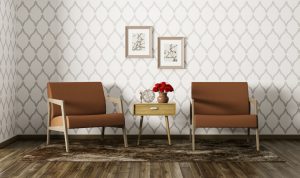How To Paint Over Wallpaper with Your Plano Painting Company
January 16, 2017
 Everyone has that room in their house with wallpaper that can generously be described as “vintage.” It either doesn’t go with the rest of your décor, or you simply want to bring the look into this decade. Either way, you’d really like to paint it, but of course, there’s the issue of the wallpaper. Do you have to remove it first? That’s a very involved and messy job, and you’d rather just paint over it and be done. Fortunately, you can do just that. Today, your Plano painting company, Platinum Painting, is going to walk you through a few simple steps that will help you completely transform your room by painting over wallpaper.
Everyone has that room in their house with wallpaper that can generously be described as “vintage.” It either doesn’t go with the rest of your décor, or you simply want to bring the look into this decade. Either way, you’d really like to paint it, but of course, there’s the issue of the wallpaper. Do you have to remove it first? That’s a very involved and messy job, and you’d rather just paint over it and be done. Fortunately, you can do just that. Today, your Plano painting company, Platinum Painting, is going to walk you through a few simple steps that will help you completely transform your room by painting over wallpaper.
The Prep Work
Most of the success when it comes to this kind of project comes down to how you prep your wall. After you’ve done that correctly, it’s like any other paint job. Of course, prepping a papered wall is a bit unique, but a few steps will help provide and ideal surface for whatever color you’ve chosen.
- Make sure your wall is free of dust by wiping it down with a slightly damp (not soaking wet) cloth. If it’s too wet it can cause the wallpaper to peel.
- Inspect your wall for holes, seams, and bubbles. For the holes, simply apply some spackle to the area, wait for it to dry, and then sand it smooth. For imperfections in the wallpaper itself, apply wallpaper glue to all the edges and seams that may be lifting. For seams that continue to stick out and bubbles, use a utility knife to remove that portion of wallpaper and apply spackle to even out the surface.
- Use painter’s tape to protect all the trim on the windows, doors, and baseboards. Also tape the edge where the wall meets the ceiling.
- Run a line of caulk around the edge of the room where the paper meets the ceiling, floor, and baseboards. This step will prevent the edges of the paper from peeling and enable you to have a straight brush line.
Now It’s Time To Paint!
After meticulously preparing your wall, it’s time to prime and paint. The key for this phase is that both your primer and your paint need to be oil-based. This is because, as you know, water and wallpaper don’t mix, so a water-based product will only cause the paper to peel and create problems.
- Apply a base coat of primer using a paint brush around the edges and a roller for the rest. Let it dry, look to see if you can still notice the wallpaper through the primer, and apply a second coat if necessary. After this, let it dry for 24 hours.
- Open a container of oil-based paint, stir, and pour it in to your paint tray.
- Just like with the primer, apply the paint to the edges using a brush and use a roller for the rest of the wall. An easy approach to this is to start in a top corner and work your way down in 3-by-3’ sections. After the first coat has dried, apply a second coat in the same manner. Remove all the painter’s tape, and now you can enjoy your new room!
For this kind of job, an eggshell or washable flat paint usually works best. If you have textured wallpaper, you may need to apply more coats of paint and primer to conceal it. If it’s extremely textured, you may need to remove it altogether so it doesn’t show through.
The 1 Step Method
Of course, another approach to this kind of job is to simply call us! We’re experts at interior painting and have done this exact type of project thousands of times. We’ll do everything for you except pick out the color of paint. We’ll even remove the wallpaper if necessary. We have been the go-to company for residential painting in Plano since 2008, so if you want a fresh room without any of the effort, just call us.
Have Questions?
Whether you decide to do-it-yourself or let us into your home, please feel free to call us and ask any questions about painting over your wallpaper. Nothing makes us happier than a well painted room, and we’re willing to help you get that in any way possible.
